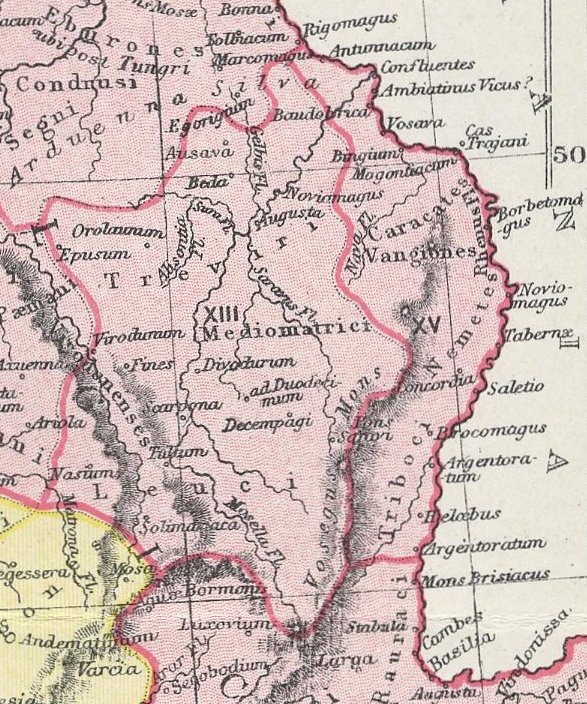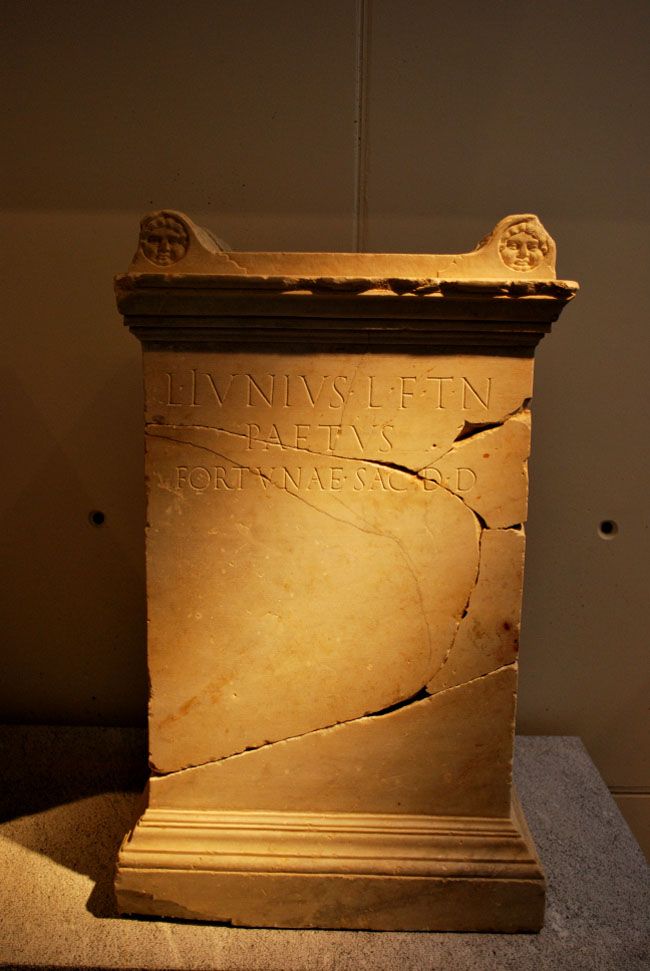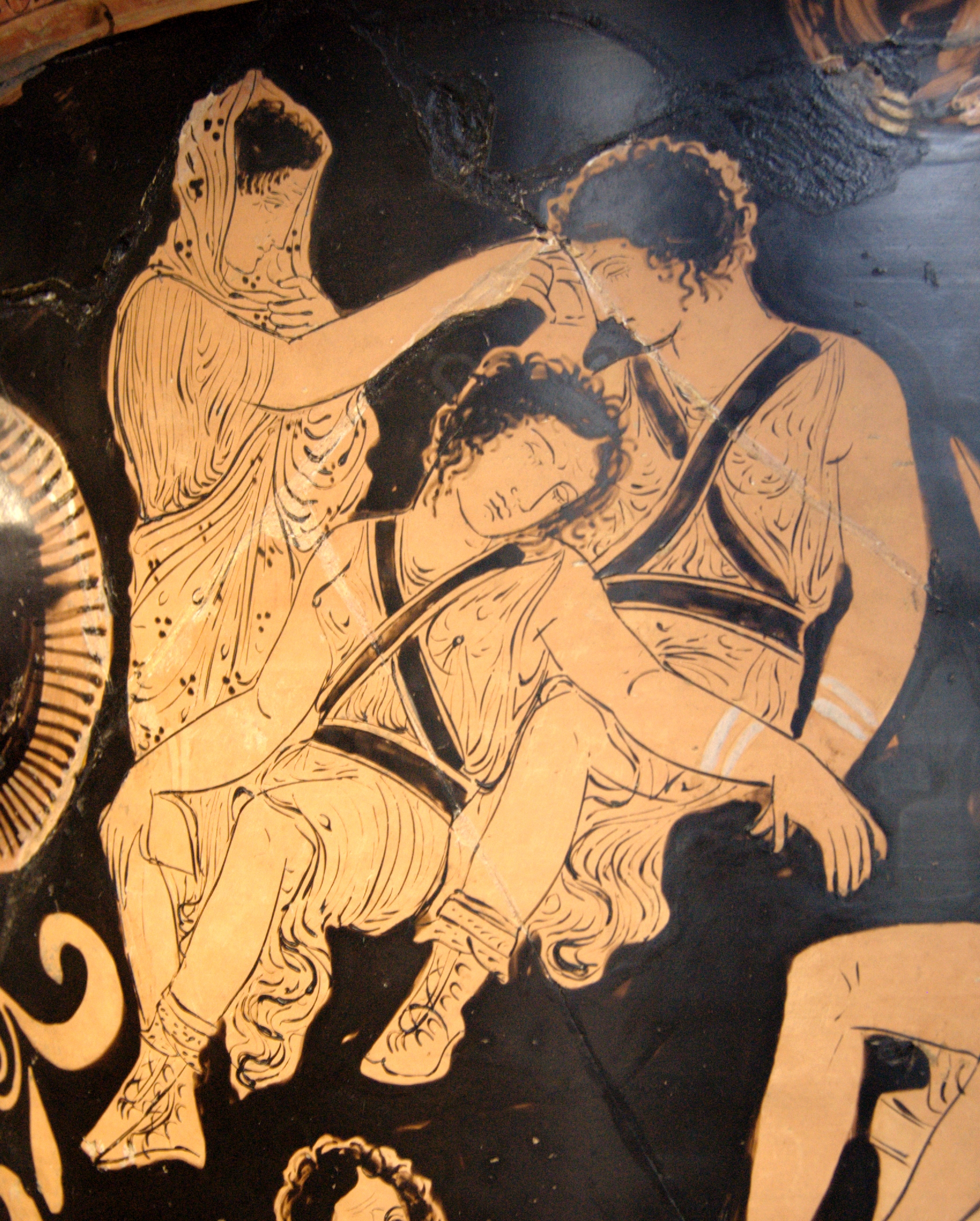|
Nemeton
A nemeton (plural: nemeta) was a sacred space of ancient Celtic religion. Nemeta appear to have been primarily situated in natural areas, often sacred groves.Koch, p. 1350. However, other evidence suggests that the word implied a wider variety of ritual spaces, such as shrines and temples.Green, p. 448.Dowden, p. 134. Evidence for nemeta consists chiefly of inscriptions and toponymy or place-names, which occur all across the Celtic world. Toponyms related to the word ''nemeton'' occur as far west as Galicia in the Iberian peninsula, as far north as Scotland, and as far east as central Turkey. The word is related to the name of the Nemetes tribe living by the Rhine between the Palatinate and Lake Constance in what is now Germany, and their goddess Nemetona. Attestations in Latin The word nemeton is explained late in a gloss by Fortunatus : « loco nomine Vernemetis… quod quasi fanum ingens Gallica lingua refert. » ("in a place called Vernemetis...which means like a ''fanum' ... [...More Info...] [...Related Items...] OR: [Wikipedia] [Google] [Baidu] |
Nemetona
Nemetona, or 'she of the sacred grove', is a Celtic polytheism, Celtic goddess with roots in northeastern Gaul. She is thought to have been the eponymous deity of the Germanic peoples, Germano-Celts, Celtic people known as the Nemetes;Beck, pp. 237-238. evidence of her veneration is found in their former territory along the Middle Rhine''Corpus Inscriptionum Latinarum, CIL'' 13, 6131. as well in the Altbachtal sanctuary in present-day Trier, Germany.Powers Coe, p. 1351.Finke 324. She is also attested in Bath, England, where an altar to her was dedicated by a man of the Gauls, Gallic Treveri people.''Roman Inscriptions of Britain, RIB'' 140. Etymology Nemetona's name is derived from the Celtic root ''nemeton, nemeto-'', referring to consecrated religious spaces, particularly sacred groves. She has been considered a guardian goddess of open-air places of worship. The same root is found in the names of the Romano-British goddess Arnemetia and the Matres and Matronae, Matres Nemetial ... [...More Info...] [...Related Items...] OR: [Wikipedia] [Google] [Baidu] |
Celtic Polytheism
Ancient Celtic religion, commonly known as Celtic paganism, was the religion of the ancient Celts, Celtic peoples of Europe. Because there are no extant native records of their beliefs, evidence about their religion is gleaned from archaeology, Greco-Roman accounts (some of them hostile and probably not well-informed), and literature from the early Christian period.Miranda Aldhouse-Green, Green, Miranda (2012). "Chapter 25: The Gods and the supernatural", ''The Celtic World''. Routledge. pp.465–485 Celtic paganism was one of a larger group of polytheistic Indo-European religion, Indo-European religions of Iron Age Europe. While the List of Celtic deities, specific deities worshipped varied by region and over time, underlying this were broad similarities in both Celtic deities, deities and "a basic religious homogeneity" among the Celtic peoples. Widely worshipped Celtic gods included Lugus, Toutatis, Taranis, Cernunnos, Epona, Maponos, Belenos, and Sucellos. Sacred springs we ... [...More Info...] [...Related Items...] OR: [Wikipedia] [Google] [Baidu] |
Celts
The Celts ( , see Names of the Celts#Pronunciation, pronunciation for different usages) or Celtic peoples ( ) were a collection of Indo-European languages, Indo-European peoples. "The Celts, an ancient Indo-European people, reached the apogee of their influence and territorial expansion during the 4th century BC, extending across the length of Europe from Britain to Asia Minor."; . "[T]he Celts, were Indo-Europeans, a fact that explains a certain compatibility between Celtic, Roman, and Germanic mythology."; . "The Celts and Germans were two Indo-European groups whose civilizations had some common characteristics."; . "Celts and Germans were of course derived from the same Indo-European stock."; . "Celt, also spelled Kelt, Latin Celta, plural Celtae, a member of an early Indo-European people who from the 2nd millennium bce to the 1st century bce spread over much of Europe." in Europe and Anatolia, identified by their use of Celtic languages and other cultural similarities.. "C ... [...More Info...] [...Related Items...] OR: [Wikipedia] [Google] [Baidu] |
Nemetes
The Nemetes or Nemeti were a tribe settled along the Upper Rhine by Ariovistus in the 1st century BC. Their area of settlement was the contact zone between Celtic (Gaulish) and Germanic peoples. According to Tacitus, the Nemetes were "unquestionably Germanic". The name of the tribe, however, is Celtic as the name of its main town ''Noviomagus'' meaning ''novios'' 'new' and ''magos'' 'plain', 'market' (cf. Welsh ''maes'' 'field', Old Irish ''mag'' 'plain'), as are those of several gods worshipped in their territory, including Nemetona, who is thought to have been their eponymous deity.John T. Koch (2006). ''Celtic Culture: A Historical Encyclopedia.'' ABC-CLIO, p. 1351. Both of these names are taken to be derivations from the Celtic stem '' nemeto-'' "sacred grove".Xavier Delamarre (2003). ''Dictionnaire de la langue gauloise.'' Éditions Errance, p. 233. In '' De Bello Gallico'', Caesar writes that the Hercynian Forest "begins at the frontiers of the Helvetii, and Rauraci ... [...More Info...] [...Related Items...] OR: [Wikipedia] [Google] [Baidu] |
Glossary Of Ancient Roman Religion
The vocabulary of ancient Roman religion was highly specialized. Its study affords important information about the religion, traditions and beliefs of the ancient Romans. This legacy is conspicuous in European cultural history in its influence on later juridical and religious vocabulary in Europe, particularly of the Christian Church. This glossary provides explanations of concepts as they were expressed in Latin pertaining to Religion in ancient Rome, religious practices and beliefs, with links to articles on major topics such as priesthoods, forms of divination, and rituals. For theonyms, or the names and epithets of gods, see List of Roman deities. For public religious holidays, see Roman festivals. For temples see the List of Ancient Roman temples. Individual landmarks of religious Topography of ancient Rome, topography in ancient Rome are not included in this list; see Roman temple. __NOTOC__ Glossary A abominari The verb ''abominari'' ("to avert an omen", from ''ab-'', ... [...More Info...] [...Related Items...] OR: [Wikipedia] [Google] [Baidu] |
Galatia
Galatia (; , ''Galatía'') was an ancient area in the highlands of central Anatolia, roughly corresponding to the provinces of Ankara and Eskişehir in modern Turkey. Galatia was named after the Gauls from Thrace (cf. Tylis), who settled here and became a small transient foreign tribe in the 3rd century BC, following the Gallic invasion of the Balkans in 279 BC. It has been called the "Gallia" of the East. Geography Galatia was bounded to the north by Bithynia and Paphlagonia, to the east by Pontus and Cappadocia, to the south by Cilicia and Lycaonia, and to the west by Phrygia. Its capital was Ancyra (i.e. Ankara, today the capital of modern Turkey). Celtic Galatia The terms "Galatians" came to be used by the Greeks for the three Celtic peoples of Anatolia: the Tectosages, the Trocmii, and the Tolistobogii. By the 1st century BC, the Celts had become so Hellenized that some Greek writers called them ''Hellenogalatai'' (Ἑλληνογαλάται). The Romans cal ... [...More Info...] [...Related Items...] OR: [Wikipedia] [Google] [Baidu] |
Antonine Wall
The Antonine Wall () was a turf fortification on stone foundations, built by the Romans across what is now the Central Belt of Scotland, between the Firth of Clyde and the Firth of Forth. Built some twenty years after Hadrian's Wall to the south, and intended to supersede it, while it was garrisoned it was the northernmost frontier barrier of the Roman Empire. It spanned approximately and was about high and wide. Lidar scans have been carried out to establish the length of the wall and the Roman distance units used. Security was bolstered by a deep ditch on the northern side. It is thought that there was a wooden palisade on top of the turf. The barrier was the second of two "great walls" created by the Romans in Great Britain in the second century AD. Its ruins are less evident than those of the better-known and longer Hadrian's Wall to the south, primarily because the turf and wood wall has largely weathered away, unlike its stone-built southern predecessor. Construction be ... [...More Info...] [...Related Items...] OR: [Wikipedia] [Google] [Baidu] |
Devon
Devon ( ; historically also known as Devonshire , ) is a ceremonial county in South West England. It is bordered by the Bristol Channel to the north, Somerset and Dorset to the east, the English Channel to the south, and Cornwall to the west. The city of Plymouth is the largest settlement, and the city of Exeter is the county town. The county has an area of and a population of 1,194,166. The largest settlements after Plymouth (264,695) are the city of Exeter (130,709) and the Seaside resort, seaside resorts of Torquay and Paignton, which have a combined population of 115,410. They all are located along the south coast, which is the most populous part of the county; Barnstaple (31,275) and Tiverton, Devon, Tiverton (22,291) are the largest towns in the north and centre respectively. For local government purposes Devon comprises a non-metropolitan county, with eight districts, and the Unitary authorities of England, unitary authority areas of Plymouth City Council, Plymouth an ... [...More Info...] [...Related Items...] OR: [Wikipedia] [Google] [Baidu] |
Bow, Devon
Bow () is a village and civil parish in the Mid Devon district of Devon, England, about west of Crediton. According to the 2021 census, it had a population of 1,120, which was slightly more than the 1,095 recorded at the 2011 Census. There is an adjoining hamlet of Nymet Tracey which shares a church with Bow and much common history. Bow is a major part of Upper Yeo electoral ward. The total ward population at the 2011 census was 1,708. History There is a 3rd millennium BC woodhenge west of the village. Its 19 post holes were discovered by aerial photography in 1984.Shirley Toulson, The Companion Guide to Devon, It is believed to have been a centre of pagan worship for a large area of surrounding countryside. The name ''Nymet'' means "Sacred Grove" in Celtic and is associated in Roman terms with the Druids. The word Nymet is preserved in many surrounding place names (e.g. Nymet Barton, Nymet Rowland, Broad Nymet). The River Yeo, which used to be called the Nymet, flows thr ... [...More Info...] [...Related Items...] OR: [Wikipedia] [Google] [Baidu] |
Roman Britain
Roman Britain was the territory that became the Roman province of ''Britannia'' after the Roman conquest of Britain, consisting of a large part of the island of Great Britain. The occupation lasted from AD 43 to AD 410. Julius Caesar invaded Britain in 55 and 54 BC as part of his Gallic Wars. According to Caesar, the Britons had been overrun or culturally assimilated by the Belgae during the British Iron Age and had been aiding Caesar's enemies. The Belgae were the only Celtic tribe to cross the sea into Britain, for to all other Celtic tribes this land was unknown. He received tribute, installed the friendly king Mandubracius over the Trinovantes, and returned to Gaul. Planned invasions under Augustus were called off in 34, 27, and 25 BC. In 40 AD, Caligula assembled 200,000 men at the Channel on the continent, only to have them gather seashells () according to Suetonius, perhaps as a symbolic gesture to proclaim Caligula's victory over th ... [...More Info...] [...Related Items...] OR: [Wikipedia] [Google] [Baidu] |
Erinyes
The Erinyes ( ; , ), also known as the Eumenides (, the "Gracious ones"), are chthonic goddesses of vengeance in ancient Greek religion and mythology. A formulaic oath in the ''Iliad'' invokes them as "the Erinyes, that under earth take vengeance on men, whosoever hath sworn a false oath". Walter Burkert suggests that they are "an embodiment of the act of self-cursing contained in the oath". Their Roman counterparts are the Furies, also known as the Dirae. The Roman writer Maurus Servius Honoratus ( AD) wrote that they are called "Eumenides" in hell, "Furiae" on Earth, and "Dirae" in heaven. Erinyes are akin to some other Greek deities, called Poenai. According to Hesiod's '' Theogony'', when the Titan Cronus castrated his father, Uranus, and threw his genitalia into the sea, the Erinyes (along with the Giants and the Meliae) emerged from the drops of blood which fell on the Earth ( Gaia), while Aphrodite was born from the crests of sea foam. Apollodorus also re ... [...More Info...] [...Related Items...] OR: [Wikipedia] [Google] [Baidu] |








